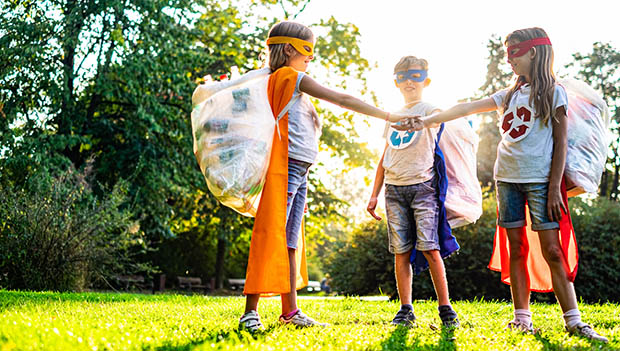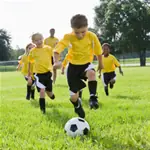
It may not always (or ever!) feel like we have the extra time to add another project or task to our to do list--especially as summer wraps up and school and extracurricular activities start in full force. For this reason, we put together a list of easy ideas for giving back that don't require too many resources or take too much time from daily routines.
Working on projects that give back with our little ones broadens their perspective to include the thoughts, feelings and needs of others as they consider their own actions, goals and dreams as they grow up.
Now is as perfect a time as any to extend our responsibilities to include small ways of helping and spreading joy to others around us. From handmade cards to volunteering at a local animal shelter, here are a few easy ways for you and your child to start giving back in your community.
Make Handmade Cards
No matter what time of year, a handmade card always brightens someone's day. Friends, family and strangers alike (perhaps a great opportunity to find a pen pal!) will find joy in receiving a thoughtful creation put together just for them.
Break out the crayons, glitter and glue to craft something beautiful, or simply help your child put pen to paper to write a thoughtful note. Here is a list of handmade card ideas to get the creative juices flowing! Now, all you'll need is your craft bin and time to cut, paste, glue, write and deliver.
Clean out to Donate
This way of giving back will immediately help you, too! We've all seen a toy bin so full that it's spilling onto the floor even when everything is "picked up." And as far as clothes go... Kids grow so fast that a routine closet clear-out is almost always necessary.
Including your child in the process of not only picking out which toys and clothes to give away, but also in actively passing them off to a home, friend or local thrift store or non-profit will help them see the impact of their giving beyond that of just cleaning up their room. Sometimes it even helps to replace some of the sadness of saying "goodbye" to beloved toys with the happiness of seeing it brighten another person's day!
Help a Neighbor With Yardwork
Raking leaves, watering plants, planting flowers, re-filling bird feeders--there's always so much to do in a yard! Whether it's to help someone catch up on duties in their yard that they're no longer able to do on their own, or simply an opportunity to give an extra hand to someone working alone, there is likely someone in your neighborhood or family/friend circle who would appreciate and benefit from this kind of "time" donation. Not to mention: There's so much for your child to learn and enjoy by spending time together outdoors.
Pick up Trash
This is another simple outdoor activity that can be easily incorporated into our daily routines, rather than feeling like an added duty to what is quite likely an already busy schedule. Bring a bag along for your neighborhood walk/hike or simply help your child find a trash can in a public gathering space or park and have them pick up a few pieces of trash they see along the way or before they play.
To make this habit extra fun (and safe!), allow your child to pick out a grabber for kids! Here are some fun sea life-themed grabbers, or go wild with this robotic arm! Giving back in this manner presents an opportunity to discuss healthy practices for our immune systems and our environment with our kids.
Deliver Groceries/Donate to Food Banks
Many communities have existing organizations that provide grocery delivery and other food services that use volunteers. Reach out to take part in one of these existing programs in your community, or simply reach out to a friend or family member in need.
Your child can help find the items in the store, mark them off the list and help with the drop off. If they're old enough to push their own cart, that's an easy added responsibility in this kind of a project. There's plenty to be learned about the organization and grocery shopping process to help fulfill this basic human need.
Similarly, you could also work with your child to distribute posters/collection bags for a non-perishable food drive in your neighborhood. Simply note the items you're looking for and a pick-up/drop-off time, deliver the posters/bags, collect on schedule and donate to the food bank together.
Volunteer at Local Pet Shelter
Depending on your local organizations there are both private shelters and humane societies that have a wide variety of volunteer opportunities, from walking the shelter dogs all the way to fostering pets in your own home.
The fostering process can be challenging as you're only signing up to provide a temporary home (and your child will eventually have to say goodbye), but the lessons in caring for animals in need are positive and lasting. For animal lovers, and especially older kids, getting connected with and trained by a local shelter will open up doors for volunteer work well into high school and beyond!
If the trek to your nearest shelter is too much of a commitment, simply reach out to your neighbors and offer to feed, groom or walk their furry friends.
Making No-Sew Face Masks
Finally, it's important to note that a lot of these ways to give back right now (even that of simply baking for friends and family from the comfort of your own home) come with the added questions about safe practices in light of COVID-19. There is the added necessity of being especially mindful of following social-distancing, hand-washing and face-covering protocols in food handling and public spaces.
For this reason, making kid-friendly masks is a simple way to help themselves and others in public. Here are two methods that require no sewing skills and minimal tools. Click here for a mask design that requires an old cotton T-shirt sleeve and a pipe-cleaner, and click here for a design that requires a bit of fabric glue and elastic. This is a great activity to do with your child to talk about giving back, taking care and being safe--all while having some creative fun together!
READ THIS NEXT: How Families Can Minimize Waste









Discuss This Article